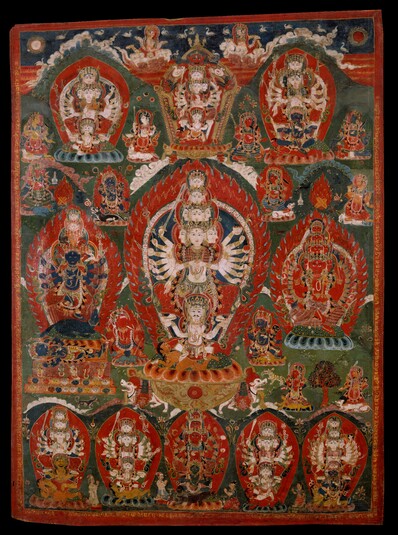
Item: Siddha Lakshmi (Indian Goddess)
| Origin Location | Nepal |
|---|---|
| Date Range | 1700 - 1799 |
| Lineages | Hindu |
| Material | Ground Mineral Pigment on Cotton |
| Collection | Rubin Museum of Art |
Classification: Deity
Siddha Lakshmi, the Accomplished Auspicious One. The inscription along the red borders dates the painting to 1796.
This unusual white goddess is the patron deity of the Malla Kings of the Kathmandu Valley and their descendants (13th to the 18th century). Associated with the Secret Black Mother tradition (Guhya Kali), her principal function is to turn back evil along with malicious spirits and negative forces. Also practiced in Bengal, she arises from the Sanskrit literature of the Jayadrataya Mala Tantra.
Multi-headed and multi-armed, brandishing weapons, white in color and peaceful in appearance, her two feet are gently supported by her subservient and dutiful consort, Shiva. Nepalese paintings follow the rule of a tightly packed composition and make use of the entire canvas filling it with deities, gods, goddesses, floral motifs and animals. A unique and welcome feature of Nepalese works of art is the routine addition of an inscription along the bottom front of a work, both painting and sculpture, almost invariably including its date of creation, hence the date 1796 for this painting.
Jeff Watt 5-2005
Front of Painting
English Translation of Inscription: [inscriptions on three sides of the red border]
Exhibition: Female Buddhas at RMA
Exhibition: From the Land of the Gods: Art of the Kathmandu Valley
Publications
Publication: Selection of Works - Painting (RMA)
Thematic Sets
Subject: Stacked Deities Page
Collection of Rubin Museum of Art: Nepal
Nepal: Late Mala Period Painting
Hindu Deity: Siddha Lakshmi Main Page
Nepal: Dated Art
